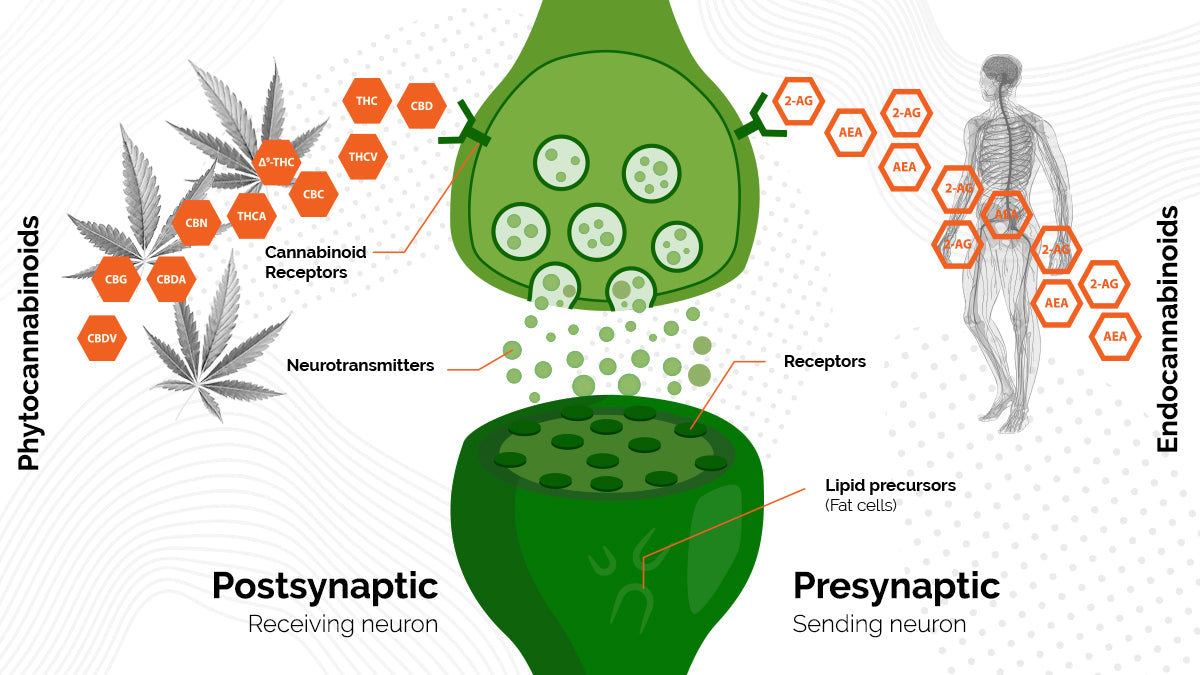In this article we discuss:
- What is a terpene?
- Where can we find terpenes?
- Terpenes for the foodie and wine lover
- Cannabis
- Are terpenes illegal?
- How do terpenes affect the body?
- What are some common terpenes and what do they do?
- Medicinal value of terpenes
- How do terpenes work with cannabis?
- How to shop for cannabis with terpenes in mind
What’s A Terpene?

Our sense of smell is an incredibly intricate system that can reveal remarkable features about the hidden world around us. Fragrance plays an important role in influencing what we’re attracted to & memories we associate them with. The scent of damp grass after a rainstorm that sparks a childhood memory. The wafting of a favorite meal that gets our mouths watering. In many ways, our noses and the sensory experiences they deliver drive our lives.
Sense of smell is a powerful apparatus that grounds human beings to the physical world. Both the smells we perceive in nature — as well as the scents we project ourselves — are extremely useful biological markers we use to help navigate our environment.
Plants, too, possess a similar system to guide their world using organic compounds called terpenes. Terpenes are the aroma and flavor molecules present in all plants and assist the plant world in a number of ways, from repelling predators to attracting insects for pollination. Terpenes also provide spectacular amounts of pleasing scents and flavors for humans and animals to relish in, like the terpenes limonene in citrus fruits and linalool in lavender, which both provide therapeutic effects beyond their captivating smells and tastes. Terpenes both enhance a sensory experience and functionally contribute to it, and we explore this dual purpose throughout this article.
Terpenes All Around Us
Popular essential oils found in many everyday products, such as body lotions and aromatherapy goods — including common natural compounds like eucalyptus, rose, frankincense, and peppermint — all contain terpenes. They are often used by consumers to relax, replenish, and reinvigorate. Some are employed for their penetrating topical effects, some ingested, and some used for their inhalant properties. A report by the Mayo Clinic relates how researchers looking at aromatherapy as a means to lessen pain after surgery found that patients who employed essential oils post-op not only had better pain management, but also reported higher overall satisfaction with their care.
Terpenes are also key natural components found in many of the foods and herbs we enjoy, including a diverse range of items like mangos, basil, and hops, which all contain the terpene myrcene and deliver relaxing, antioxidant, and anti-inflammatory effects.
Terpene Aroma and Flavors
While early research is still trying to determine possible health benefits that terpenes may provide, the aroma and flavors benefits of terpenes are well established. Different terpenes give weed a different flavor and smell, which can draw you (or push you away) from certain strains. Here are some of the most prominent aromatic notes and associated terpenes:
Pine
Experienced weed vapers have probably come across strains with the distinct smell and taste of pine. Here's your chance to know the primary terpenes responsible for that aroma! They include:
- Alpha-Pinene: leans a bit sweeter and sharper
- Beta-Pinene: tends to have earthy aromas mixed in with the pine
- Carene: very strong pine and woody smells.
Fruit
Weed strains with fruity notes are often big winners with their sweet, palatable tastes. Here are some of the major terpenes responsible for those flavors:
- Limonene: very citrusy (as the name implies)
- Myrcene: traditional fruity with clove-like sweetness
- Paracymene: also very citrusy, but sweeter than limonene
Wood
Hearty, wood aromas can be found in weed, too, which is caused by terpenes like:
- Beta-Caryophyllene: traditional wood aroma
- Humulene: wood and earth notes mixed
- Terpinolene: wood with smoky notes
Floral
Finally, many cannabis strains have light, delightful floral notes. These are great choices for vapers who want complex flavors without being overwhelmed by more pungent flavors. Take a look at some of the floral terpenes:
- Citronella: gently floral with soft citrus and rose
- Geronial: noticeably sweet with hints of rose
- Linalool: sharper, spicier floral notes
Wine Lovers Can Thank Terpenes

These multifaceted terpene compounds also exist naturally in a vast collection of beverages enjoyed all throughout the world.
Ever since the first sophisticated nose whiffed a glass of hearty red, wine lovers far and wide have reveled in the power of terpenes. Acting as the organic building blocks for an array of grape varietals, terpene flavors help to create some of the best tasting wines on the planet.
In Muscat grape cultivars, the terpenes linalool, geraniol, and nerol produce sweet-smelling aromas ranging from orange blossom to rose to coriander. Similarly, with celebrated, renown white wines like Riesling, Gewürztraminer, and Torrontés, are all varietals that owe a good portion of their popularity to notable and recognizable aromas from terpene profiles.
Additionally, a recent trend has seen terpenes taken beyond wine and used as additive mixtures by bartenders to liven up craft cocktails at high-end bars and restaurants. New terpene-based drinks are now popping up in chic locales, wowing consumer taste buds and providing appetizing flavors for a fresh generation of cocktail lovers looking for a new twist on an old concept.
Terpenes Flourish In Cannabis
Of the thousands of plants that contain terpenes, cannabis hosts the most terpenes by far. These powerful little compounds have defined the taste, smell and feel of cannabis without even being recognized. Over the past decade, however, enjoyment and exploration of terpenes in cannabis has exploded. As appreciation grows for the profound role that terpenes play, both in flavor and overall experience, more cannabis users are making terpene content part of their decision.
While a whole range of terpenes have occurred naturally in the cannabis plant for a very long time, another compound in cannabis — namely the popular, high-inducing component tetrahydrocannabinol (THC) — has consistently taken center stage. This focus on increasing levels of THC has ramped up the buzz factor and stolen the limelight from cannabis terpenes. But if the cannabis flower itself is the current floral rock star, then terpenes are the hard-working roadies running the show behind the scenes.
Another reason cannabis consumers are becoming more aware of terpenes is due to cannabis in general gaining legitimacy across America and reaching formerly untouched segments of the population. With cannabis currently legal throughout the entire U.S. in the form of hemp (and marijuana legally permissible either medically or recreationally in a solid majority of states) cannabis users are increasingly delving into the multifaceted, healing components of the cannabis plant. Deepening appreciation of terpenes is encouraging cannabis users to experiment even further, exploring different strains and appetizing terpene profiles.
What was once a substance known principally for its ability to get users high is now equally as popular for its multilayered properties, including cannabis’ flavorful and curative terpenes.
What Are The Medicinal Benefits of Terpenes
Different terpenes offer different possible medical benefits. While the research is still early and ongoing for how terpenes impact our bodies, there's already a lot of promising evidence of the benefits terpenes may provide. On top of that, terpenes might enhance the effects of cannabinoids in an entourage effect, similar to how we see different cannabinoids interact.
With these caveats noted, let's take a closer look at the possible (and exciting) medicinal benefits that terpenes might be able to provide.:
Possible Antiviral
Early research suggests that terpenes and essential oils may have antiviral properties. It's important to keep in mind that most of the results were in vitro, which means they studied what happened in a petri dish. More research is needed to see how terpenes might be antivirals when used in vivo, or used inside the human body.
Some of the specific terpenes in this study include carvone, camphor, and alpha and beta-pinene.
Possible Anticancer
Similarly to antiviral properties, terpenes have shown to possibly have anticancer properties as well. Again, most of the research is in vitro, and more rigorous research is needed to see if those antiviral properties translate to in vivo applications.
Terpenes of note from this study include limonene, pinene, and terpinene. If further research demonstrates that these terpenes show anticancer properties in vivo, it may open the door to exciting new cancer treatments that avoid the terrible side effects of chemotherapy and radiation.
Anxiety and Depression Management
An enormous amount of antidepressants available on the market contain terpenes, since many terpenes have natural anti-depressant and calming properties. Two terpenes that are most commonly found in antidepressant medication include beta-pinene and linalool.
Other cannabinoids (especially CBD) have been shown to be a potential option to manage anxiety and depression. It's possible that combining CBD and these targeted terpenes might be extremely useful tools in helping to manage chronic mental health conditions.
Pain Management
Finally, there was a recent study that stated that certain terpenes might be able to duplicate the pain-relieving effect seen with other cannabinoids. This is promising early research for people looking for new ways to manage pain, especially if they don't tolerate cannabis well.
The terpenes focused on in this study include linalool, geraniol, and humulene. According to the research, these terpenes might be able to provide pain relief because they bind to the CB1 receptors of your endocannabinoid system. If this seems familiar, it's because THC binds to the same ones, which is how it produces its traditional high, and provides potential pain relief.
It's important to note that this study drew its data from rats, and human interactions with terpenes or their effect on pain management is still in very early research. While it hints at exciting ways to treat pain without negative side-effects, remember to put these claims in the context of preliminary, early research.
Are Terpenes Legal?
In and of themselves, terpenes contain absolutely no psychoactive qualities and are not considered illegal in the U.S. under the Controlled Substances Act. Because terpenes are not exclusive to the cannabis plant, they are frequently derived from other legal plants — which has led to many different expressions of terpenes extracted from a variety of flora, including lemongrass, peppercorn, mint, junipers, and many others.
In fact, companies are rapidly sprouting up around the U.S. and capitalizing on the concept of terpene additives. One recent high-profile example was Kim Kardashian West's baby shower, who provided guests with terpene-infused teas for a "CBD and Meditation"-themed celebration. Terpenes can also be found in lotions, make-up, chocolates and candles among others.
There are a host of terpene-flavored mixtures that mimic the properties and unique tastes of cannabis without using any illicit plant material at all, and are completely legal across the U.S. Companies are creating blends with flavors representative of old cannabis standbys beloved for decades like: OG Kush, Sour Diesel, and Granddaddy Purple, to name a few. Made from the essential oils of legal plants, they are as lawful to produce as the cooking herbs present in most household cupboards.
How Do Terpenes Affect The Body?

If you’ve ever thought that a trip to the forest brightens your day both physically and mentally, there’s a reason why — and terpenes have a lot to do with it.
Research by the National Institutes of Health (NIH) into the curative nature of visiting the forest shows that those good vibes you experience go far beyond simply relaxing and disconnecting from the stresses of everyday life. Scientists are finding that “forest aerosols,” which contain large quantities of naturally occurring terpenes, may be beneficial to human health. Studies prove that merely walking through a forest can have the effect of bathing a person in beneficial terpene compounds. Outcomes from the research include anti-inflammatory, tumor-fighting, and neuroprotective effects.
The terpene pinene, which can be found in pine trees and rosemary, has been proven to have significant anti-inflammatory effects. When pinene was employed in combination with compounds from frankincense and linalool, notes the NIH, there was an even greater anti-inflammatory effect. Treatment with linalool alone was also found to inhibit cigarette smoke-induced acute lung inflammation by inhibiting infiltration of inflammatory cells. The terpene caryophyllene is showing signs of protecting against neuroinflammation in Parkinson’s disease.
Besides inflammation, it turns out that terpenes are also proving hopeful as cancer-fighting agents. The NIH points out that numerous studies have demonstrated the protective effects of the terpene limonene against chemical-induced tumors in various tissue types, including breast, intestine, pancreas, liver, and colon cancers.
The downside appears to be negligible, as initial research is showing that terpenes are not known to produce any negative side effects. And being a compound found in a multitude of legal plants, terpenes won’t make you fail a drug test.
Common Terpenes and Their Properties
| Terpene | Taste & Smell | Benefits |
| Beta-caryophyllene | Spicy | pain reliever, anti-inflammatory |
| Humalene | Herbal, woodsy | anti-tumor, cancer fighter, anti-inflammatory |
| Limonene | Citrus, pine | anti-inflammatory, antioxidant |
| Linalool | Herbal, lavender | pain relief, stress & anxiety relief |
| Myrcene | Herbal, mango | pain relief, calming |
| Pinene | Pine, rosemary | anti-inflammatory, eases joint pain |
| Terpinolene | Herbal, pine | antioxidant, cancer fighter |
Terpenes--Better Than Popping A Pill?
Americans are historically not shy about their drug use, be it illegal or prescribed by a physician. Whether seeking help for conditions like chronic pain, sleep issues, or weight loss, Americans tend to often reach for a pill first.
While it’s an accepted clinical fact that benzodiazepines such as Valium, Ativan and Xanax are meant for short-term pain relief, a new study found that long-term abuse of those substances increased by 50 percent between 2005 to 2015. It appears that seemingly helpful remedies prescribed by doctors for chronic pain, anxiety disorders, or sleep issues can sometimes cause more problems than they’re designed to cure.
There is some good news, though. Just as drug dependence is reaching dangerous levels in the U.S., it appears that users are now increasingly reaching for less pharmaceutical-driven approaches to care. A New York Times article noted a recent study by the journal “Frontiers in Behavioral Neuroscience” that showed inhaling lavender, which contains the terpene linalool, had calming effects very similar to popping a Valium. This new insight could be a key step towards developing terpene compounds for clinical use in treating anxiety disorders.
Some terpenes are even proving to have positive side effects that are somewhat counterintuitive — like the terpene humulene found in hops and cannabis that actually suppress user appetites. Also common in ginseng, clove, and sage, humulene has been used in traditional Chinese medicine for generations.
How Are Terpenes Related To Cannabis?

Terpenes were once mostly anecdotal information, casually referenced by cannabis users as a part of the plant. Today, thanks to harder scientific research, we have a more accurate understanding of terpene’s influence.
While THC has for many years been the most highly touted compound in cannabis — and CBD (cannabidiol) is seemingly showing up everywhere as a miracle cure — it’s more accurate to see cannabis as consisting of hundreds of dynamic compounds working in concert with one another. Known as the “entourage effect,” ultimately, it’s this combined energy that fuels the power behind cannabis and terpenes.
This year, the National Center for Biotechnology Information (NCBI), which advances science and health by providing access to biomedical and genomic information, agreed that “the case for cannabis synergy via the entourage effect is currently sufficiently strong as to suggest that one molecule is unlikely to match the therapeutic and even industrial potential of cannabis itself as a phytochemical factory.”
And one prevailing wing of that factory includes terpenes.
Combining the sedating properties of, say, linalool with the anti-anxiety effects of CBD is thought to provide the effect of boosting each aspect of the plant and creating a combo positive outcome that is greater than the sum of its parts.
Because the cannabis plant is made up of integral pieces all working together, terpenes have been known to also affect the quality and intensity of user highs. Some terpenes may increase the potency of a cannabis high, while others may lessen it. While particular terpenes may not directly influence the high-inducing aspects of cannabis, they unquestionably play a role in how certain types of cannabis may make users feel. For instance, some cannabis users report that combining cannabis and mango — which contains the terpene myrcene — has the effect of enhancing and extending user highs. Similarly, users describe accounts of cannabis rich in the terpenes limonene, pinene, and caryophyllene as creating their own characteristic results.
How to Shop for Terpenes in Cannabis
Terpenes can be found in the world all around, and they likely play a larger role in your life and overall wellness than you realized! Since consuming terpenes with cannabis has such promising benefits, cannabis companies are giving more attention to listing terpene contents than THC and CBD alone.
Load-your-own vaporizers, such as the Firefly 2+, let users take advantage of “the entourage effect” and “whole plant medicine,” without the irritation of traditional smoking. Firefly 2+ is made with dynamic convection heating elements, allowing users to benefit from the full spectrum of terpenes in their cannabis or herbal plant, which all have different boiling points.

When strain shopping, consider the dominant terpenes in addition to cannabinoids. Leafly is an excellent resource for terpene profiles of various strains. Experiment with what flavors and aromas are most enjoyable.
Remember that terpenes affect not only the taste and smell but also the feeling and overall experience, so think about your cannabis goals. For example, some terpenes (such as linalool) are powerful relaxers and are perfect for unwinding at night. Others, such as limonene, are more invigorating and are a proven aid against depression. While just about all terpenes are pretty potent antioxidants and anti-inflammatory, humulene and myrcene stand out for pain relieving properties. Understanding how terpenes add to the cannabis experience enables users to explore strains with confidence.









